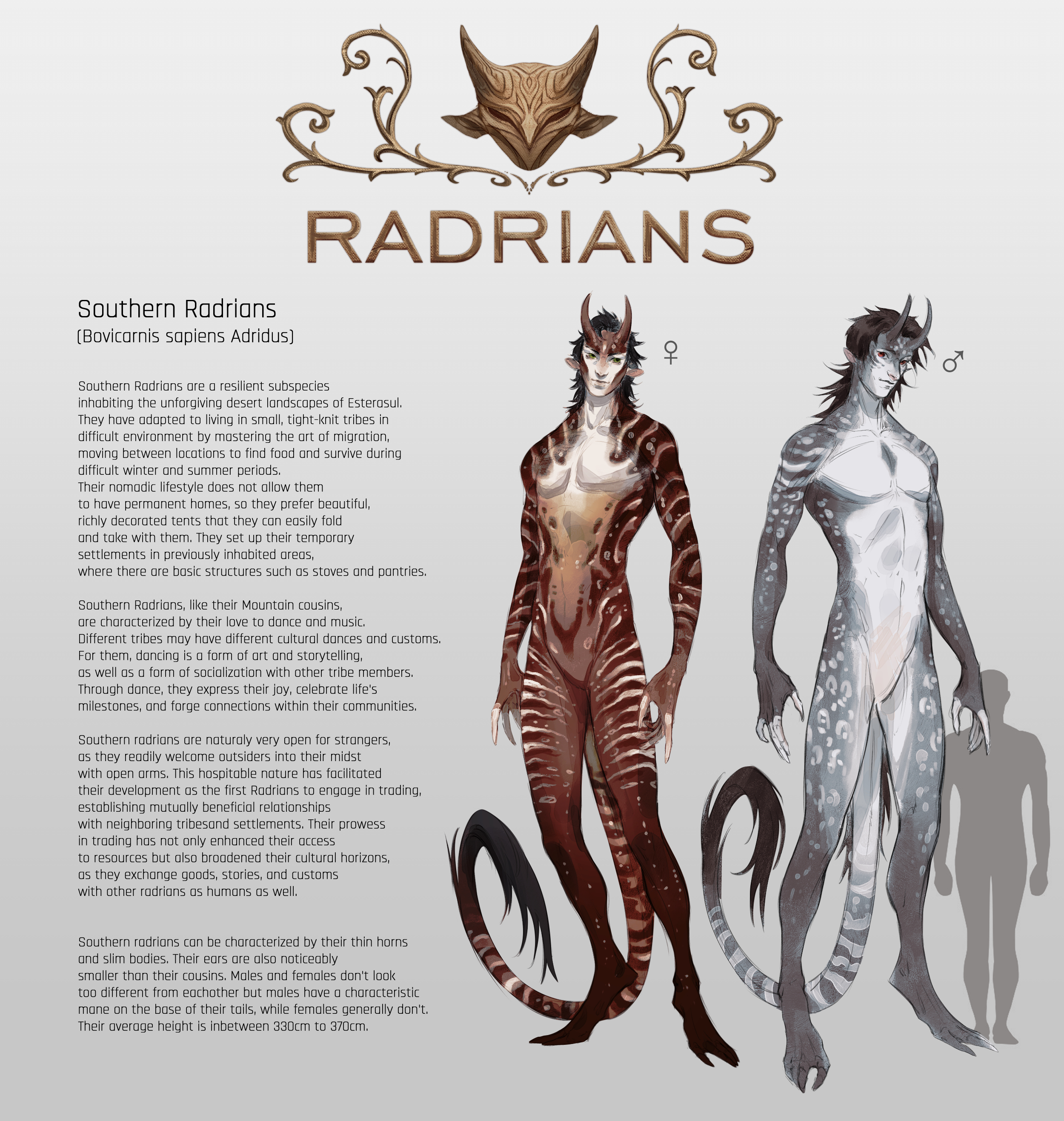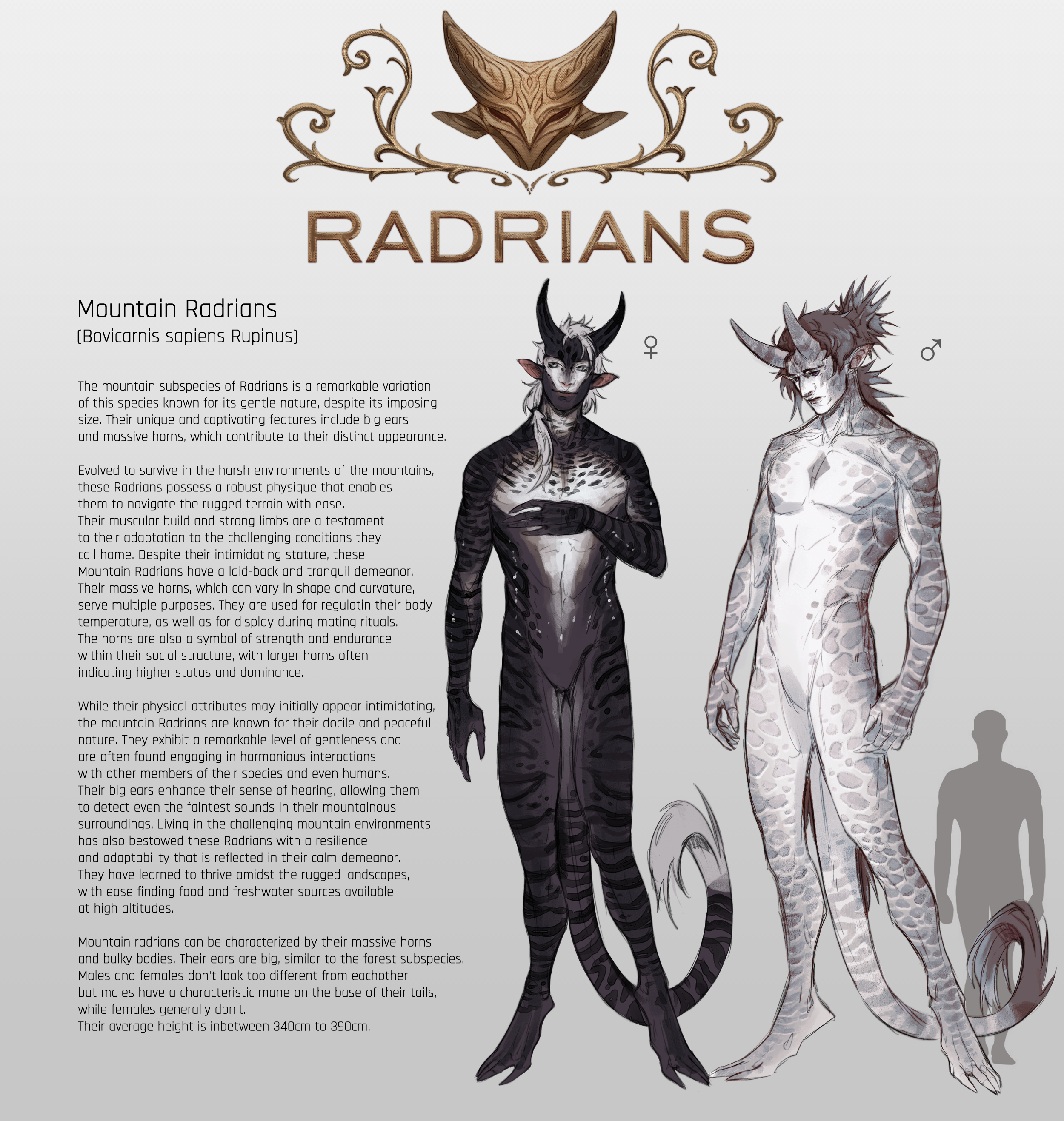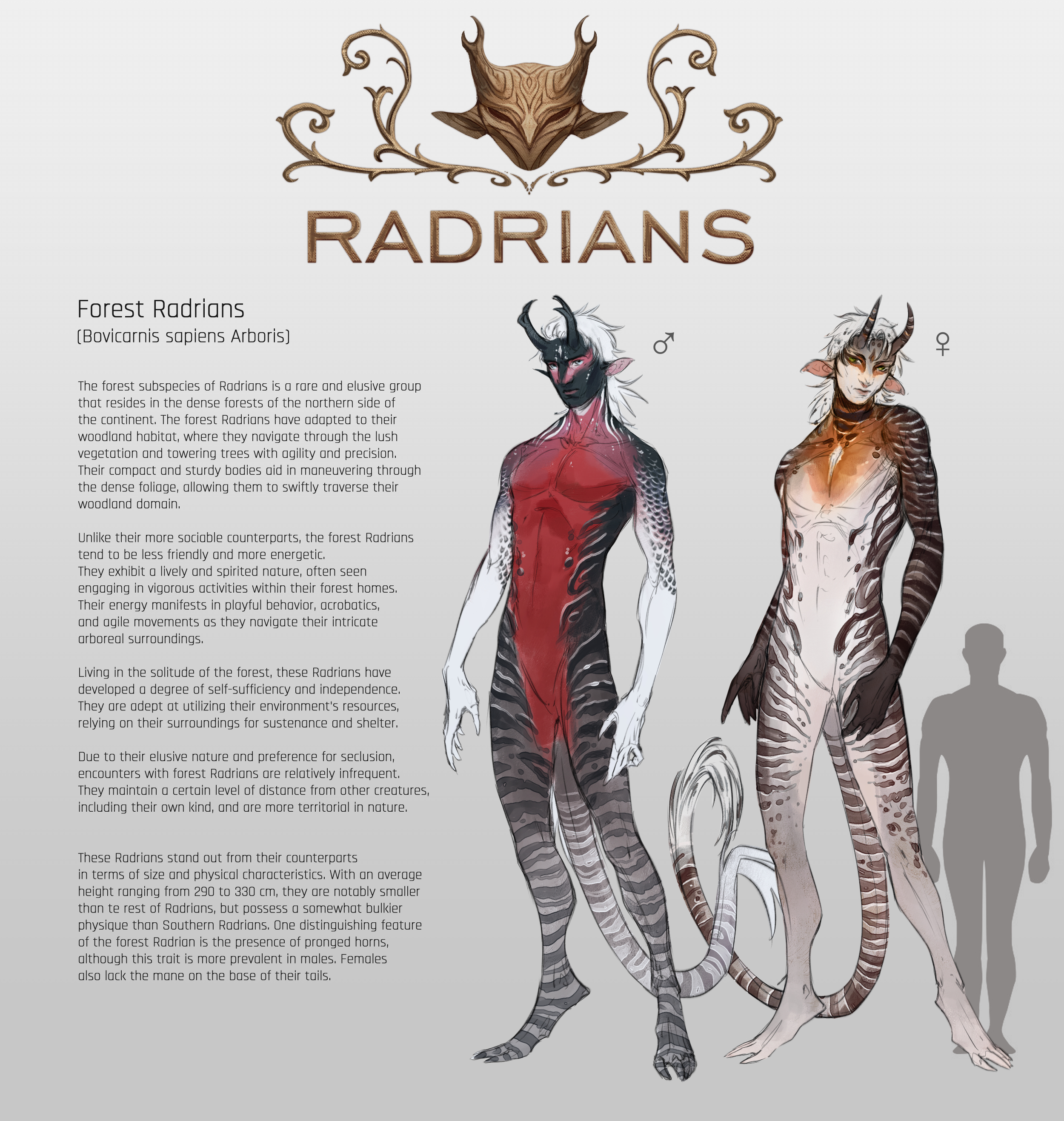Southern Radrians
 The Southern subspecies of Radrians is a fascinating variation known for its affinity for jewelry and intricate craftsmanship. These desert-dwelling Radrians have a penchant for decorating their daily life items and accessories, both for themselves and their companions. Their creativity and attention to detail are evident in the ornate designs that adorn their surroundings.
The Southern subspecies of Radrians is a fascinating variation known for its affinity for jewelry and intricate craftsmanship. These desert-dwelling Radrians have a penchant for decorating their daily life items and accessories, both for themselves and their companions. Their creativity and attention to detail are evident in the ornate designs that adorn their surroundings.
Measuring an average height of 330 to 370 cm, the Southern Radrians possess slender bodies and delicate features. Their horns are relatively thin compared to other subspecies, reflecting their emphasis on aesthetics and personal adornment rather than imposing physical attributes. Their ears are noticeably smaller, suggesting a specialization for their desert habitat.
Living in close proximity to the desert, the Southern Radrians have adapted to the arid and harsh conditions of their environment. They have developed a keen understanding of the resources available and have learned to thrive in this challenging landscape. Their slim bodies allow them to maneuver swiftly through the desert terrain, utilizing their agility to navigate sand dunes.
One of the most distinctive aspects of the Southern Radrians is their fondness for jewelry and decorative craftsmanship. They spend a significant amount of time meticulously crafting and embellishing various items, from intricate necklaces and bracelets to intricately designed trinkets and tools. Their creations serve both practical and aesthetic purposes, reflecting their appreciation for beauty and individual expression.
The Southern Radrians' affinity for jewelry extends beyond their own personal adornment. They often create and exchange accessories as tokens of friendship and social bonding within their community. These jewelry pieces become cherished symbols of connection and camaraderie among the Southern Radrians, further strengthening their social ties.
As the most common subspecies of Radrians, the Southern Radrians form a vibrant and thriving population in their desert habitat. Their resourcefulness, creativity, and sociability contribute to their ability to adapt and flourish in the arid conditions. They bring a touch of artistic flair and a sense of community to their surroundings, making the Southern Radrians a captivating and integral part of the Radrian species.
Mountain Radrians

The mountain subspecies of Radrians is a remarkable variation of this species known for its gentle nature, despite its imposing size. Standing at an average height of 340 to 390 cm, these magnificent creatures are the largest among the Radrian subspecies. Their unique and captivating features include big ears and massive horns, which contribute to their distinct appearance.
Evolved to survive in the harsh environments of the mountains, these Radrians possess a robust physique that enables them to navigate the rugged terrain with ease. Their muscular build and strong limbs are a testament to their adaptation to the challenging conditions they call home. Despite their intimidating stature, these mountain Radrians have a laid-back and tranquil demeanor.
Their massive horns, which can vary in shape and curvature, serve multiple purposes. They are used for regulatin their body temperature, as well as for display during mating rituals. The horns are also a symbol of strength and endurance within their social structure, with larger horns often indicating higher status and dominance.
While their physical attributes may initially appear intimidating, the mountain Radrians are known for their docile and peaceful nature. They exhibit a remarkable level of gentleness and are often found engaging in harmonious interactions with other members of their species and even humans. Their big ears enhance their sense of hearing, allowing them to detect even the faintest sounds in their mountainous surroundings.
Living in the challenging mountain environments has also bestowed these Radrians with a resilience and adaptability that is reflected in their calm demeanor. They have learned to thrive amidst the rugged landscapes, with ease finding food and freshwater sources available at high altitudes.
The mountain Radrians are a captivating subspecies, admired for their grandeur and the unique harmony they bring to their harsh surroundings. Despite their immense size and impressive physical traits, they are peaceful beings, embodying the balance between strength and tranquility in the mountainous realms they call their own.
Forest Radrians

The forest subspecies of Radrians is a rare and elusive group that resides in the dense forests of the northern side of the continent. These Radrians stand out from their counterparts in terms of size and physical characteristics. With an average height ranging from 290 to 330 cm, they are notably smaller but possess a somewhat bulkier physique.
The forest Radrians have adapted to their woodland habitat, where they navigate through the lush vegetation and towering trees with agility and precision. Their compact and sturdy bodies aid in maneuvering through the dense foliage, allowing them to swiftly traverse their woodland domain.
One distinguishing feature of the forest Radrians is the presence of pronged horns, although this trait is more prevalent in males. These prongs add an additional element of uniqueness to their appearance, showcasing a touch of complexity and strength.
Unlike their more sociable counterparts, the forest Radrians tend to be less friendly and more energetic. They exhibit a lively and spirited nature, often seen engaging in vigorous activities within their forest homes. Their energy manifests in playful behavior, acrobatics, and agile movements as they navigate their intricate arboreal surroundings.
Living in the solitude of the forest, these Radrians have developed a degree of self-sufficiency and independence. They are adept at utilizing their environment's resources, relying on their surroundings for sustenance and shelter. Their ability to adapt and thrive in the forest ecosystem contributes to their rarity and the air of mystery surrounding them.